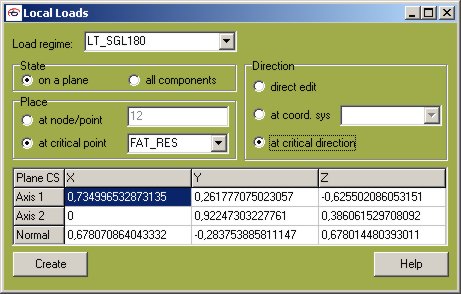
Local Loads
The use of this command allows you a generation of a local load history in either tensorial form or as a sequence of normal and two shear load components. Its appearance is like this:

The user has to select some of previously defined load regimes. In the State radio group he selects which mode of the output he prefers.
1) The option all components will generate the local load history of stress or strain tensor or both of them, in dependency on the result file used for the load regime definition. The next necessary choice concerns the Place dialogue. The user either directly writes the specific node or element number or the isolated point name, for which he wants to produce the local load history, or selects the option at critical point. If there is any fatigue result file concerning the chosen load regime, the maximum of the damage parameter is looked for and the related point/node/element is written to the edit box above (here the node 12).
2) The other option is on a plane, which produces a description of normal and shear components on a specified plane. The selection in the Place dialogue is similar as above, but the situation is complicated further, that the orientation of the plane's normal line has to be specified. If the critical point was chosen in the previous Place dialogue, then the default choice is at critical direction. The most of the multiaxial calculation methods look for the critical plane (critical plane methods) or have at least some plane being the most loaded one (integral methods). If such a method is chosen in the critical point dialogue, the normal line orientation is copied from the details of the fatigue calculations to the third line of the Plane CS table and the cartesian system is completed with the resting axis. The user has nevertheless an option to directly edit the normal line through the option direct edit.
The push of the Create button is followed with a query, what will be the ID-name of the new local load history.
Beware: Once a local load history is created, its relation to any particular load regime or some specific position is lost. Bear that in mind, when you are choosing the relevant ID-names for the load histories!
More:
multiaxial calculation methods
© PragTic, 2007
This help file has been generated by the freeware version of HelpNDoc